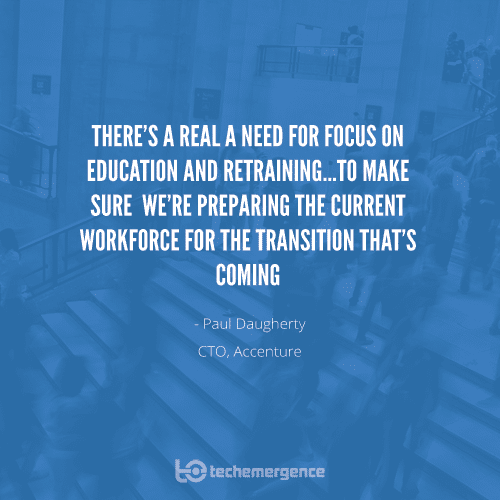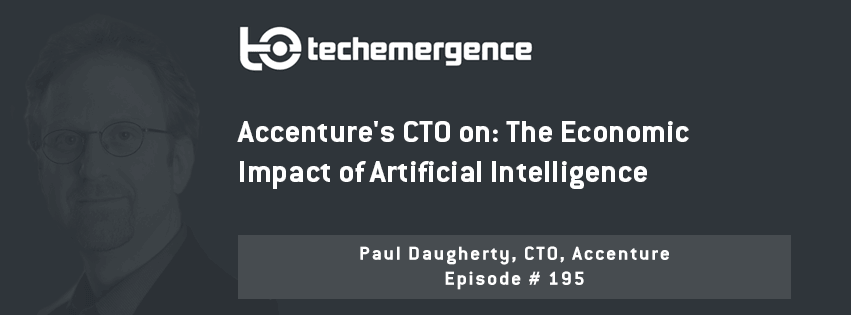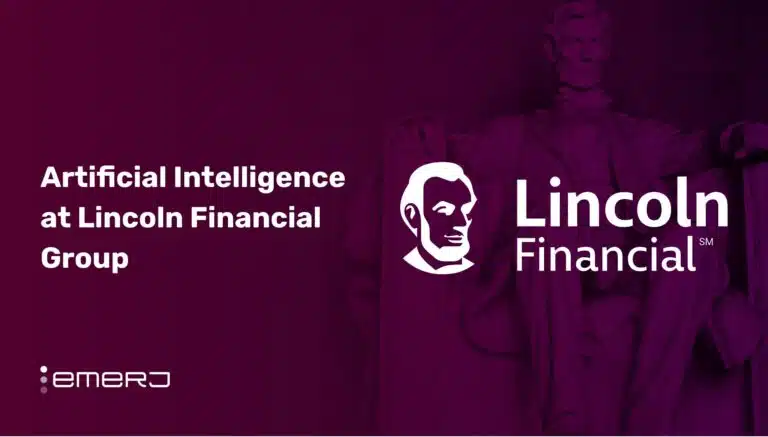Episode Summary: Accenture is a leading global professional services company in the tech space, providing services to many of the Fortune 500 and their global equivalents. The company recently conducted a study, combined with expertise from economists and AI researchers, about the longer-term economic impact of artificial intelligence around the world. In this episode, I spoke with Chief Technology Officer Paul Daugherty, who has been with Accenture since 1986, and who was joined by Global Technology R&D Lead Marc Carrel-Billiard. We met up at a coffee shop after an AI Summit in San Francisco, and I asked Paul and Marc about what they had learned from this newly-published study and what they consider to be the significant impacts of *AI and automation on the future job market.
Expertise: Technology strategy and business innovation management
Brief Recognition: Paul Daugherty is Accenture’s CTO and leads the company’s Technology Innovation & Ecosystem group. He is also a member of Accenture’s Global Management Committee. He also leads the company’s highly skilled, certified technology architects, who apply new technologies and architectural foundations in building solutions for clients across industries. In addition, Mr. Daugherty is responsible for managing Accenture’s alliances, partnerships and senior-level relationships with leading and emerging technology companies, and runs Accenture’s CIO Council of more than 200 global CIOs. Before being named chief technology officer in 2012, Mr. Daugherty was Accenture’s chief technology architect, founded Accenture’s cloud computing business, and led Accenture’s technology business globally for the Resources operating group. He was instrumental in founding Accenture’s SaaS, big data and open source businesses, and played a key role in the company’s technology business during the major transitions to client/server computing and internet-based computing. He earned his bachelor of science degree in computer engineering from the University of Michigan.
Current Affiliations: CTO of Accenture; Chairman of the Board of Avanade; Board Member for Accenture Global Services Limited; Board Member of the Computer History Museum; CIO Advisory Board Member for NPower
Interview Highlights:
The following is a condensed version of the full audio interview, which is available in the above links on Emerj’s SoundCloud and iTunes stations.
(1:27) You talk about gauging the economic impact of AI…what are some of the nuances that went into measuring what that impact will be in the future?
Paul Daugherty: We came up with this report on the impact of AI; the simple question we asked was, “How will AI impact business and what its impact be on the economy?”
We worked with Frontier Research and we looked at 12 countries that make up about half of the world’s GDP…so the kinds of things you need to look at are – what’s the structure of their economy, what kinds of industry do they have, what’s their capacity of research and development, what kind of ecosystems do they have around innovation…you look at the underlying economic data and a lot of those factors and dig a little deeper and say, for categories of jobs and work that are important in their economy, how can AI technology change those and how will it change their productivity and how will that drive underlying economic improvements, and that’s the way the analysis works…
…that fundamentally led to the conclusion that, even with some conservative assumptions, that we have the potential to double economic growth rates in those economies over the next couple of decades by application of AI, and a key reason for that is by improving human productivity by up to 40 percent in the way that they do their work.
(3:28) What are the industries that maybe are more primed than others?
PD: We do see application across industries…but you do see marked differences across countries in terms of how they’re positioning for technologies AI…one of the things we looked at is a factor called national absorptive capacity, which is how quickly a country can absorb and spread the impact of a new innovation. The U.S. would score very highly on this metric, its innovation with capital, with investment, with education, with learning…we can absorb and move technology very quickly, very different than certain parts of the world that might have labor constraints, which might not have the capital to inject into the ecosystem…
…the other question is, what’s the nature of the underlying industry, that’s why we see in Japan as tripling its growth rate…because they have a pretty strong absorptive capacity, strong research, strong R&D, strong industrial base, and if they leverage that in the right way, they can drive strong uplift around the industrial sector.
(5:30) Is it possible that…population density is a factor…is that what aids in disbursement, or is it less about geography?
PD: I think geography has an impact in some industries…for example, in B2C models, countries like the U.S. and China have an advantage because the size of the consumer populations means you can bring a new business model to scale quickly…you can bring a Google or Amazon to scale very quickly…in the industrial industries, what we see is the policy itself can have a big impact; in Germany for example, they have a program called industry 4.0, championed by Chancellor Merkel…those kinds of initiatives make a big impact on their GDP growth.
(7:07) What are some of the facets of what’s happening in Japan…that might leave them more primed than France or another country?
Marc Carrel-Billiard: We believe that all research activity can be bound together by telling a story and manufacturing, whether you’re building a product or making a product…it applies for every type of industry, whether you talk about life science and you just designed a new drug, whether you talk about oil and gas and you’re building a refinery or a well…if you look at activation agents, you can extend the boundaries, because it’s a very multidisciplinary approach…
…what we’re going to be able to see is that by combining IoT and machine learning…all these different things, you’re going to be able to change the way we build a product and manufacture a product…the flexibility of these products will not come from the hardware, but from the software.
(9:58) There’s this whole notion of shedding the light on dark data…it seems to me as though it’s almost harder to give any advice beyond that because the creative process per business is going to be so different…is that right?
PD: I think that’s right, and I think that’s why we need a different formula for business, and I think the way business has worked in the 20th century isn’t going to work going forward for the remainder of the 21st century, because you need to imagine the business differently, and we use the word imagination, reimagining business and business processes…how do we think about the business model – think about each of your business processes, look at he data that’s available and new data that you might acquire, and think about the way your employees and consumers work with systems and machines, and mix that all together and create a different formula for your business, and we believe that’s the era we’re moving into…
(11:25) In some way, it reminds me of this idea that, “wouldn’t the future be great” if the dull and the boring could be automated, and we could just think…
MC-B: We believe that machine learning…will help people to get into business opportunities, parse out the activities that they don’t want to do, and focus more on their passions….it’s very interesting to try and re-appropriate the stuff you really like to do, I think it’s very positive for people…
…there’s a lot of things that people don’t think about. Look at a platform like Google Translate, it’s an amazing platform because you can leverage and integrate refugees coming to countries to learn about the language…they get integrated faster, they get a job faster – nobody thought about that, but people are using it this way…I think we’re going to see many examples of this.
(13:30) Where does one find (case studies and tangible examples)…where does one glean the basic building blocks of what these ideas (for reimagining) could be?
PD: We’re at the early stage…the challenge is finding the patterns, and that’s something we’re very focused on…you have to apply patterns across industry. So, we applied AI in the drug discovery and clinical trials process and pharmaceuticals, and what can you learn about that might apply in the product development process for a consumer goods company, and you have to look at how you can learn from one application and apply it to another…it’s a stage of experimentation. There’s a phrase we use that I think speak swell with how to approach this with AI, which is think big (which is the imagination), start small and find something you can apply it to on a comparative scale faster, and move it out through enterprise
(16:15) “People first” is how you’re aiming to facilitate AI and keep that as your framework moving forward, what does that look like in practice…what does people first mean when it’s in real life?
PD: I think the promise is this 40 percent productivity improvement – how do we make people more effective so they can do what they want to do…for example, a large manufacturer that we worked with, we looked at their assembly line workers and developed a solution that equipped them with augmented reality headsets that had laser-guided precision assembly capabilities, combined with machine learning capabilities that learned about their performance and best practice on how to do their job, and this technology allowed these workers to do broader sets of work, to increase their capabilities faster. The company loved it because they could advance the productivity of their workers and the workers get better quality output faster…that’s the promise we see with the technology, a win-win-win in that case. We use the phrase, if you apply this right, it’s about making humans super, not making super humans…
…we believe strongly in this people-first approach and the view that this is good overall for jobs and the economy; however, there’s a real fact that there will be some dislocations, because some of the jobs and roles displaced today are going to displace people who need to become relevant in the new world, so there’s a real a need for focus on education and retraining. I think there’s an obligation among business and government educational institutions working together to make sure we’re preparing the current workforce for the transition that’s coming and preparing the workforce that’s coming for the new transitions…I think it requires leadership from business and institutions about thinking bigger about the right way to drive this impact to get to the right goal.
*Interested in what other experts have to say about artificial intelligence and the future of industry? Have a look at our roundup of the latest valuations of the artificial intelligence market by segment.


























